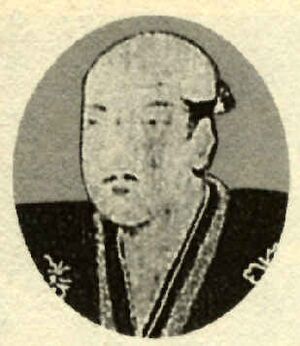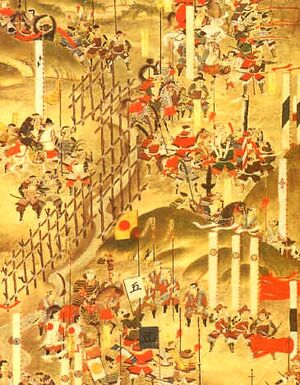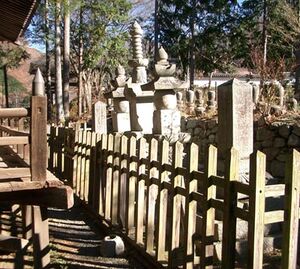Takeda Katsuyori was a younger son of Takeda Shingen and prior to Shingen's death, the head of the Suwa Clan. In 1542 Takeda Shingen had defeated Suwa Yorishige and taken his daughter as a mistress, a relationship that in 1546 produced Katsuyori. Katsuyori was born into troubled circumstances. His mother was seen as the product of unfortunate circumstances and hardly on the same level as the Lady Sanjo, Shingen's principle wife and a woman of courtly blood and refinement. Shingen avoided possible controversy by naming Katsuyori the head of the Suwa Clan (hence the 'Yori' in his name); as Suwa Katsuyori he was removed from the Takeda family to a greater or lesser degree, and posed no threat to the heir, Takeda Yoshinobu. This did not prevent Shingen from making use of Katsuyori in battle, where the young man proved himself a brave and exceptionally skilled fighter.
In 1565, a plot involving Takeda Yoshinobu came to light and the heir was ordered to commit seppuku two years later, a reasonably unusual event even for the Sengoku Period. This complicated matters quite a bit as far as the succession issue was concerned, and in the end, Shingen arrived at a compromise. He would allow Katsuyori's son, Nobukatsu, to assume leadership once he came of age. In the meantime, Katsuyori was to act as guardian.
As long as Shingen ruled, Katsuyori's good points were allowed to shine through. He distinguished himself in battle against the Hojo in 1569 and against the Tokugawa in 1572, demonstrating almost reckless bravery. The Koyo Gunkan, while hardly a trustworthy document, states the Katsuyori was a fierce warrior and engaged in a number of individual duels with enemy samurai. But Shingen died in 1573, and Katsuyori was suddenly in charge of a war machine and system of governance that had taken his father thirty years to build. Initially, he rose to the challenge. Carrying on his father's war with Tokugawa Ieyasu, he managed to bring down Takatenjin Castle in 1574 and prepared in 1575 to defeat Ieyasu decisively. He planned to capture Ozaki Castle in Mikawa, assisted by a treacherous minister who promised to throw open the gates when the Takeda arrived. This would isolate Ieyasu at Hamamatsu in Totomi, and probably lead to his surrender or death. Unfortunately for the Takeda, the plot was uncovered by the Tokugawa, and Katsuyori called off the attack, deciding instead to invest Nagashino Castle. Intended as something of a consolation prize (if popular tradition is correct on this point), Nagashino proved a tough nut to crack, resisting attempts at mining, burning, and direct assault. Katsuyori decided to lay siege, and threw up a perimeter about the castle. A brave defender, however, managed to slip through the net (literally) by swimming out via river. This man, Torii Sune'emon, managed to reach Ieyasu and warn him of Nagashino's plight. After some prodding, Oda Nobunaga agreed to throw his own might into the relief effort, and at length a 38,000 man army drew up across from the Takeda at Nagashino. At this critical point, common sense abandoned Katsuyori. While much has been made of the rifles Nobunaga is said to have had in such abundance at the battle, a Takeda victory would probably have been unlikely regardless. Katsuyori's troops were already tired from the siege, and in need of refit. The territory separating the two armies was rough, unsuited for the sort of aggressive cavalry tactics that the Takeda had always relied on. Furthermore, 38,000 to the Takeda's 14,000 or so were long odds for the latter, made longer still by the need to mask Nagashino castle with 2,000 of those men, leaving hardly 12,000 for the actual attack. Needless to say, Katsuyori's generals virtually begged their lord to reconsider his decision to attack - to no avail. Katsuyori was probably blinded by the possibilities. He had the opportunity (however slight it should have seemed) to kill both Ieyasu and Nobunaga in one stroke, a stroke which would completely change the political situation and possibly vault the Takeda to a position of national importance. On the same token, if he retreated, the Takeda's reputation would be damaged, and his own leadership questioned. He would likely never have another chance to dispose of both of his clan's hated rivals. Unfortunately for most of his warriors and old generals, he did not choose the one course of action he probably should have-do nothing. Ieyasu is supposed to have commented later "…if he had taken up a position behind the Takigawa River he could have held us up for ten days anyhow, and we should have had to retire. Then he could have launched an attack on us, and ten to one it would have been successful. It is a pity he was such a fool."[1] This is made the more unfortunate when one considers that Baba Nobufusa had suggested just such a course of action to Katsuyori before the attack.
Thus, on 28 June 1575, Takeda Katsuyori ordered the Takeda army to attack the Oda and Tokugawa positions, which were now strengthened by the inclusion of wooden palisades (virtual proof Nobunaga and Ieyasu had counted on Katsuyori's aggressiveness getting the better of him). For hours, the mêlée raged, and in the end, nearly 16,000 men were dead, of whom 10,000 were Takeda. Many of the renowned Takeda Generals - Baba, Yamagata, Naito, Hara - were slain, and in the end, Katsuyori was forced to flee north towards Shinano.
It is perhaps both surprising and a testament to Katsuyori's sheer tenacity that the Takeda Clan limped on for another seven years. Incredibly, Katsuyori continued to trouble the Tokugawa, and fought off and on with the Hojo clan. He was clearly less then popular by now with the people of Kai, for his disastrous defeat in 1575 had forced him to make heavy drafts; he also allowed his father's cleverly designed system of government to run off course. Perhaps the final straw was his decision in 1581 to move the Takeda capital from Kofu to near Nirayama. The new castle was almost a monument to the extent to which the Takeda had fallen, for Shingen had never bothered with a castle of his own – Tsutsuijigasaki had been a fortified mansion. In the end, however, time ran out on a clan whose spirit had been broken at Nagashino. In 1581 Taketenjin fell to the Tokugawa, a strategic and moral blow to the Takeda. That winter, Katsuyori's retainer, Kiso Yoshimasa of Fukushima in Shinano, discontented at material demands related to the building of Nirayama, rebelled. Katsuyori immediatly raised an army, heedless of bad weather, and marched against Fukushima in what developed into a pointless fiasco that crushed whatever morale his clan had left. A few months later, a combined army of Oda, Tokugawa, and Hojo troops invaded Kai and Shinano. The majority of Katsuyori's troops abandoned him outright, including such Takeda stalwarts as Oyamada Nobushige and Anayama Nobukimi, and the son of Shingen met his end at his own hand in the shadow of the Temmokuzan with his son Nobukatsu while his last few retainers, three Tsuchiya brothers, held the enemy at bay. The Takeda domain thus fell to the Oda and Tokugawa.
Notes on the Text
- ↑ Sadler, A.L. The Maker of Modern Japan. pg. 105-106


